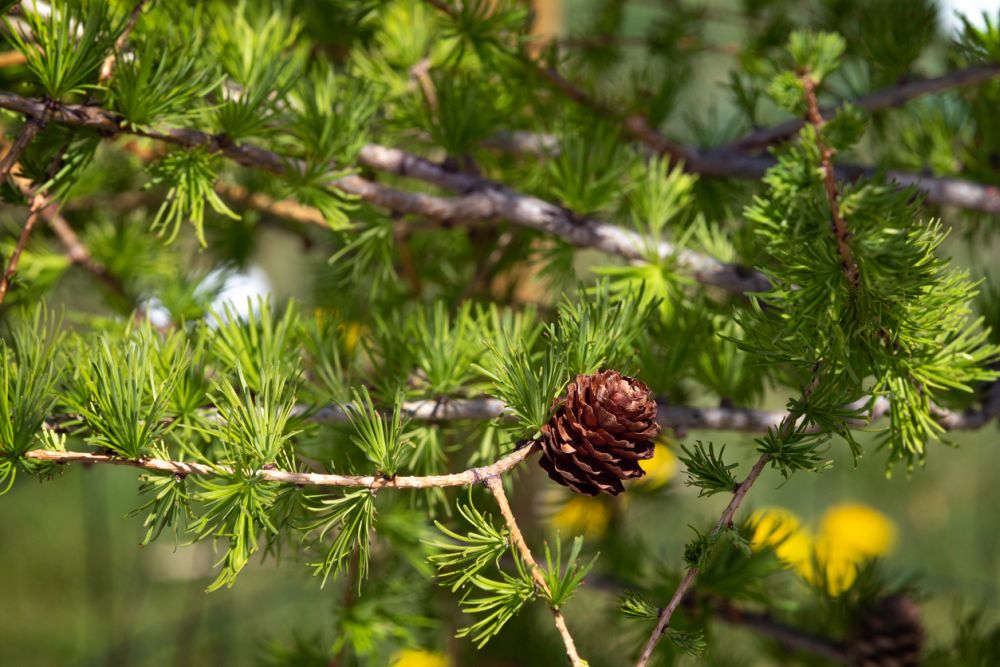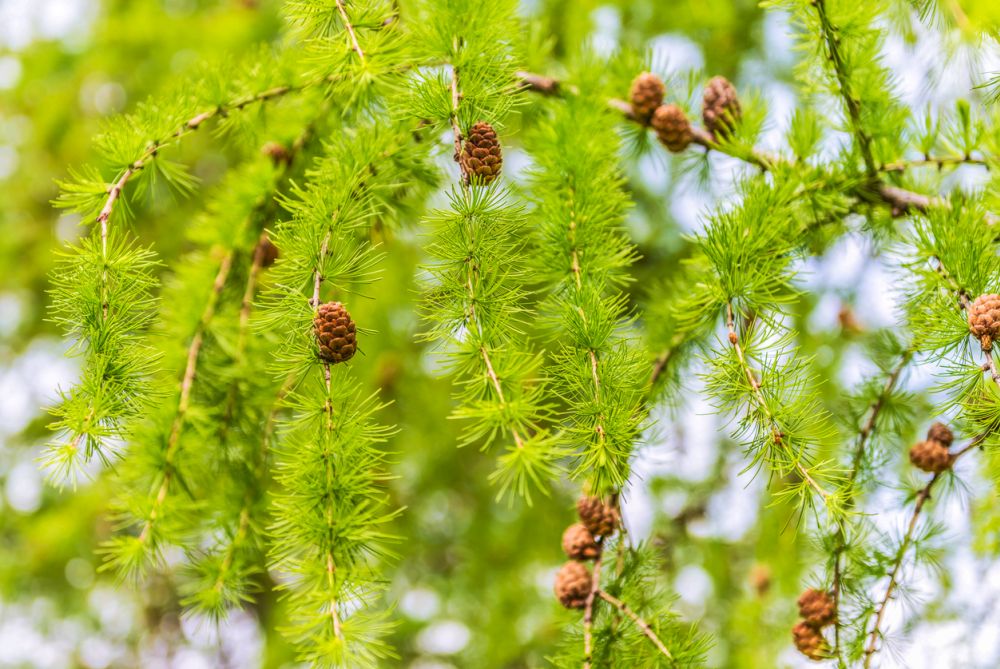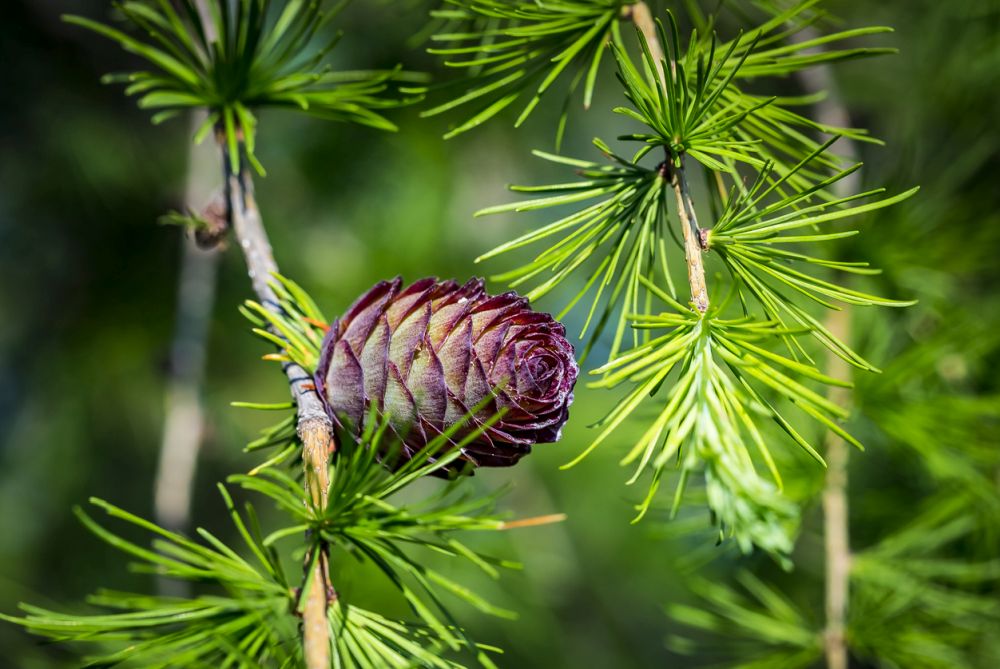Larch Tree Info: How To Grow And Care For The Larch Tree
Is information technology a tree or a stick in the mud? Some people ask that question when they expect at the larch tree in a garden. Just that's not fair of class. The larch tree is a whole tree in every sense of the give-and-take. From the trunk and the bark to the branches and leaves, the larch is a tree well worth the name and designation in the horticultural world.

And so why does the larch tree get this bad rap and why is it unfair? To answer this long-winded question, we demand to become upwardly close to this conifer and run into what makes it stand out. So we look at how you can plant it in your garden and have intendance of it all twelvemonth circular.
The Larch Tree at a Glance
When you take a tree that grows to 120 feet such as the larch tree, that'due south reason to be proud of not something to look downwardly upon. The towering behemothic of a tree is a native of Northern Europe where the climate is colder than usual. This means that apart from the Eastern Larch, it'south not easy to find it in the U.s. growing naturally in parks or forests. However, y'all can all the same grow information technology in your garden as we'll show you after.
Unlike other conifers, the larch tree (Larix) is deciduous. Yep, it'southward a giant of a tree with cones and needles just like pine or a fir tree. Nevertheless, come winter and they shed their needle-like leaves and brace for the freezing winter. Only not earlier their leafage turns into stunning gold in the fall. So much for existence a stick in the mud.
In its native Europe, the larch tree grows in mountainous regions where its summit quality wood is exported to all corners of the world. And while you won't abound the larch tree in your yard or garden for its forest, the landscaping values of this wonderful tree are beyond doubt.
One of the beginning things that get your attention to this tree is the leaves. They look like flat needles and take a low-cal green hue that looks near translucent in the sunlight. The leaves explode into little clusters of 30 to 40 needles in each grouping. The bark of the tree is rather thick. It is often brown with some pink highlights.
Larch Tree Varieties

While flowers are not the most distinguishing feature of many larch varieties, these blooms still make a modest splash in the summer. Before the cones materialize, you'll see pink flowers growing shyly among the needles. They're usually too small to accept an impact on the leaf, but the tree looks vivid light-green and later dazzling gilt even without the need for large blooms.
As with all landscaping copse and plants, the more than diversity you have, the improve. Everyone wants to make their garden or lawn unique. The larch tree comes in many varieties and you lot tin can option one or ii to create that landscape that makes your garden stand up out and make the neighbors jealous.
- European Larch: I of the largest and almost expansive larches you can come across. Often called the Male monarch of Larches, the intricate branches of this conifer require plenty of space that well-nigh gardens don't have. However, it's a magnificent tree notwithstanding the size.
- Eastern Larch: The only larch that claims Us soil as its natural habitat. Information technology prefers wet and acidic soil such every bit in the Midwest. Often known as Tamarack, this larch is oft seen growing near lakes. It's notwithstanding likewise big for many gardens and lawns.
- Pendula: Also known as the Weeping Larch, this is often favored for its ornamental value and its relatively small size. The cascading leaves give an astonishing spectacle especially when they plough gold in the fall.
- Japanese Larch: While very much similar to the European Larch both in stature and foliage, this multifariousness is a little unlike. It boasts of blue needles and drooping branches that you lot don't oftentimes run across in other larches. Information technology still prefers acidic soil over an alkaline i.
- Varied Directions: A unique proper noun to a unique tree. Information technology has the same features equally the Pendula with the cascading leaves merely with one exception. This variety merely grows almost 15 feet high and most 30 feet wide. That's still a lot of space, but this tree deserves every inch of it.
- Blue Sparker: The smallest of the larches. It only reaches 12 feet at full maturity. If you have a small garden or desire to plant a larch in your lawn, this is the tree to grow. It also has those bluish needles that made the Japanese Larch so famous.
How to Grow the Larch Tree
Equally with many conifers, at that place are two ways to abound a larch tree. Yous can grow it from seeds or using a cutting. The seed method is rather lengthy and requires plenty of time and patience. If you want to go a good head first, and then we recommend you utilize a cutting. Here are the piece of cake steps of growing a larch tree from a cutting.
- The best fourth dimension to brand a cut from a mature larch tree is in the early morning when the branches are soft and flexible.
- Choice a straight branch about 6 to 8 inches long and brand a cutting using a sharp pocketknife.
- Brand sure the branch has a few nodes to facilitate the growth of leaves.
- Cover the cut cease of the branch with moisture paper towels and keep information technology in the fridge to prevent information technology from going dry out.
- Meanwhile, you get your soil set. Pick a medium-size pot with enough of drainage holes at the lesser.
- Fill the pot with equal parts, soil, peat, and perlite. This is the type of slightly-acidic soil that your larch enjoys and thrives in.
- Take out the cutting from the fridge and cleanse the end with alcohol.
- Remove all the leaves from the branch before planting.
- Brand a hole in the pot almost 4 inches deep and plant the cutting.
- Fill the pigsty with soil and pack it lightly to make sure the branch is standing upright on its ain.
- Water the pot until the excess water flows out the drainage hole. Keep the soil moist but don't overwater it.
- Go along the pot in a dim-lit room for a couple of weeks. In one case the roots abound, you tin can move it to a room flooded with light.
- When the plant is used to the light and conditions outdoors, you can constitute information technology in its permanent place in the garden or lawn.
Larch Tree Care

Care for the larch tree is about looking subsequently the new tree in the first couple of years of its life. Once it soars high in the sky, all you lot need to care about is a niggling pruning and collecting the cones that fall to the footing.
Water
It's important to become the water needs of the growing larch just correct to prevent harm to the roots and keep fungal infections at bay. The larch prefers moist soil but not also wet. Y'all'll demand to allow the soil get dry before you irrigate it. To help you become the wet level correctly in the soil, you can utilize mulch around the base of the tree. Don't let the mulch touch the trunk. Spread a thick layer (well-nigh 3 inches) of oak bawl or wood shavings to improve water retentiveness and end weeds from growing there.
Fertilizer
No matter how rich the soil you grow the larch tree in, it's not enough to sustain this behemoth conifer. You lot still demand either a chemical fertilizer or an organic ane. The best time to fertilize the larch tree is in mid-bound before the growth spurt. Try a x-viii-6 fertilizer that'south loftier in nitrogen to better the growth rate of the tree. To do that you need to dig minor holes in a circle around the tree. Fill the holes with fertilizer and comprehend them with soil. Now water the tree as usual letting the fertilizer cook slowly with every irrigation and nourish the roots of the tree.
Pruning
When you take a tree that spreads its intricate branches xx or 30 feet broad, that means y'all have a pruning problem on your hands. Pruning is probably the merely event you'll take with the larch. To make it easier for y'all, you should focus on the master co-operative. Every tree has a primary branch where most of the growth takes identify. Prune this branch as regularly equally you can when the tree goes fallow. About experts recommend yous create an umbrella shape of the awning. You can achieve this by going afterward the branches that grow both upwardly and down. Exit the branches spreading wide to make full up the umbrella. If this seems like too much work, yous tin can always leave the tree to abound naturally.
Diseases and Pests
Both the wet soil and the needle-like leaves make the larch a target of many diseases. Most mutual among them are black spots, brown spots, lesions, and streaks. They all bear on the leaves and bark and are the result of fungal infections. Bad air circulation and trapped humidity are the causes of this fungus. Make sure the tree has enough space and get plenty of air apportionment effectually it.
An infestation of sawflies and aphids is not something to take lightly. They tin can ruin the beauty of the leaf and impact the growth of the tree. Spray the leaves and branches with a mixture of h2o and insecticidal soap to get rid of these pests.
Source: https://www.diys.com/larch-tree/
0 Response to "Larch Tree Info: How To Grow And Care For The Larch Tree"
Post a Comment